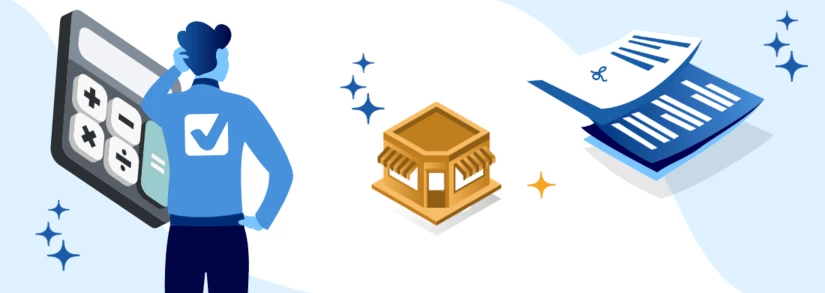Business Energy VAT : Register, Calculate & Benefit Schemes

In the dynamic landscape of Irish business, understanding the ins and outs of Value-Added Tax (VAT) is pivotal. This powerful financial mechanism impacts enterprises of all sizes and sectors. If you're grappling with questions like "What is VAT?" or "How do I calculate VAT?", you're in the right place. In this article, we'll break down the complexities of business VAT in Ireland, providing insights into VAT rates, calculations, acquiring a VAT number, and more.
What Is Value Added Tax (VAT)?

VAT, or Value-Added Tax, is a consumption tax imposed on the value added at various stages of the supply chain. It's a fundamental part of the Irish tax system, generating substantial revenue for the government. Essentially, VAT is added to the price of goods and services at each point of sale.
What is VAT? In essence, VAT is a way for the government to collect a portion of the value that business energy providers add to products and services as they move along the production chain.
How Does VAT Work?
Value-Added Tax (VAT) is a key component of modern taxation systems, designed to capture a portion of the value added to goods and services at each stage of their production and distribution. Let's see how VAT works.
- Stages of Production and Distribution
Imagine a product's journey from raw materials to the hands of a consumer. At each stage, value is added through processes like manufacturing, packaging, and marketing. VAT is levied on this incremental value.
- Businesses Act as Tax Collectors
Businesses play a pivotal role as intermediaries in the VAT process. When a business sells a product or service, it charges VAT on the selling price. This VAT is collected on behalf of the government.
- Input and Output VAT
Businesses both pay and collect VAT. The VAT they collect is referred to as "Output VAT," and the VAT they pay on their expenses is called "Input VAT." The difference between these two is what the business owes to the government.
- Tax Burden Distribution
While businesses collect VAT from customers, the actual tax burden is carried by the end consumer. This is because businesses pass on the VAT they pay on their expenses to the consumer in the form of higher prices.
- Avoiding Double Taxation
To prevent double taxation, businesses can deduct the Input VAT they've paid from the Output VAT they've collected. They then remit the difference to the government. This ensures that only the value added at each stage is taxed.
- VAT at Different Rates
Different goods and services might have varying VAT rates. For instance, essentials like food might have lower rates, while luxury items might have higher rates. This differentiation helps shape consumer behaviour and tax revenue.
- Government Revenue Generation
VAT generates significant revenue for governments. Since it's levied at each stage of production and distribution, even small increments of value contribute to a substantial cumulative tax amount.
- Simplicity and Efficiency
VAT is often praised for its simplicity and efficiency. It's relatively easy to administer and harder to evade compared to other tax systems. This contributes to its popularity among governments.
- International Implications
In international trade, VAT can be a factor in determining the final cost of imported goods. Exported goods are often exempted from VAT to promote global competitiveness.
- Encouraging Documentation
To claim Input VAT deductions, businesses must maintain accurate records of transactions and expenses. This encourages better financial practices and documentation.
It's a collaborative effort between businesses and governments, where businesses act as tax collectors, and consumers ultimately shoulder the tax burden. Understanding how VAT works is essential for businesses to comply with regulations and make informed financial decisions.
What Are the VAT Rates in Ireland?

VAT rates aren't static; they pulse with financial activity. They determine how much VAT a business charges and pays on transactions.
VAT registration threshold If your business surpasses the specified VAT registration thresholds, which are €37,500 for services or €75,000 for goods within a 12-month period, VAT registration becomes obligatory. For rest, it is optional.
| Type | Rate | Goods or Services |
|---|---|---|
| Standard | 23% | Any goods and services falling outside the scope of reduced-rate categories are subject to VAT at this percentage. |
| Reduced | 13.50% | For specific activities in the tourism sector, including hotels, restaurants, cinemas, and hairdressing. Additionally, building services and photography |
| Reduced | 9% | Certain foodstuffs; newspapers and periodicals; admission to cultural events; use of sports facilities; hairdressing; e-books and digital publications |
| Reduced | 4.80% | Livestock intended for use in the preparation of foodstuffs (excluding chickens), greyhounds, and horse hire. |
| Zero | 0% | Applies to exports, as well as items like tea, coffee, milk, bread, books, children's clothes, children's shoes, and oral medicine for both humans and animals. |
How To Calculate VAT for Businesses in Ireland?
Understanding how to calculate VAT is vital for accurate financial management. The standard VAT rate in Ireland is currently 23%. To calculate VAT, use the formula:
VAT Amount = Total Price * (VAT Rate / 100)
For instance, if your product costs €100, the VAT amount would be €23. The total price including VAT would be €123.
- VAT Exemptions
- Medical services:Includes healthcare professionals such as doctors, dentists, nurses, and physiotherapists.
- Educational services:Recognised institutions, including primary, secondary, and higher education establishments.
- Financial and insurance services:A range of offerings from banks, credit unions, insurance firms, and similar financial entities, this exemption spans services like lending, deposits, investment management, and a diverse array of insurance policies.
How To Register for VAT In Ireland?
- Complete a tax registration form
Fill out the appropriate tax registration form, either online through Revenue Online Service (ROS) for businesses within Ireland or using a paper form for businesses located outside Ireland.
- Provide evidence of trade
During registration, provide evidence that your business engages in trade with Ireland. This December involve submitting invoices, contracts, or other relevant documents that demonstrate your business activities within the country.
- Assessment by Revenue
The Revenue authorities will review the information and evidence you've provided. They'll evaluate whether your application aligns with the VAT registration criteria, considering factors such as your trade activities and business context.
- Acceptance or rejection
Based on their assessment, the Revenue will decide to approve or reject your VAT registration application. If approved, you will be assigned a unique VAT number for your business.
- In case of rejection
If your application is not accepted, don't be discouraged. You can address any issues or gaps by gathering additional documents or information. Once you've resolved the concerns raised by the Revenue, you have the option to resubmit your application later.
- Ensure ongoing compliance
After receiving your VAT number, it's crucial to understand and fulfil your VAT obligations. This includes timely filing of VAT returns and making prompt VAT payments to remain compliant with tax regulations.
- Prerequisites to apply for VAT number
- Proof of requirement
- Trading activity in Ireland
- Invoices from Irish suppliers and customers
- Information on the directors’ residence
- Physical office address
- Supporting documents could include contracts, business plans, bank statements, and other relevant records.
How To Process VAT Returns and Fillings?
This crucial process ensures accurate reporting of your VAT transactions to the tax authorities. Let's delve into the ins and outs of VAT returns and how to navigate this fundamental aspect of VAT compliance.
- Overview of VAT Return Filing Requirements
A VAT return is a report that outlines the VAT you've collected on sales and the VAT you've paid on purchases. This report enables tax authorities to assess the VAT liability or refund owed to you. Whether you're a mandatory or voluntary registrant, filing VAT returns accurately and on time is vital.
- Frequency of VAT Return Submissions
The frequency of VAT return submissions varies based on your business's turnover and the nature of your activities. Submissions can occur on a monthly, bi-monthly, or quarterly basis. Larger businesses often submit monthly or bi-monthly returns, while smaller businesses December opt for quarterly submissions.
- Understanding the VAT Return Form
The VAT return form, often accessible through the Revenue Online Service (ROS), is divided into sections that capture different types of VAT transactions. These sections typically include:
- Output VAT
This section records the VAT you've collected from your customers on your sales.
- Input VAT
Here, you report the VAT you've paid on your business expenses.
- Net VAT
This is the difference between Output VAT and Input VAT, indicating the VAT amount payable or refundable.
- Additional Information
Some transactions, like intra-community acquisitions or reverse-charge mechanisms, might require additional reporting.
- Output VAT
- Deadlines and Consequences of Late Filing
VAT return deadlines vary depending on your filing frequency. It's crucial to meet these deadlines to avoid penalties and disruptions to your business operations. Late filing can result in financial penalties or interest charges, impacting your bottom line and reputation.
How To Deal with VAT Inspections and Meet Compliance?
VAT compliance is a critical aspect of business operations, and it extends beyond timely filing and accurate reporting. Understanding the potential for VAT inspections by the Revenue Commissioners is essential for businesses to maintain smooth operations within the tax framework.
- Random VAT Inspections
The Revenue Commissioners have the authority to conduct random VAT inspections on businesses. This means your business could be chosen for inspection without any prior notice. These inspections are meant to ensure that businesses are following VAT regulations accurately.
- Importance of Accurate Records
Keeping thorough and accurate records is a cornerstone of VAT compliance. Proper documentation of transactions, invoices, and related documents is crucial for a seamless VAT inspection process. The absence of proper records can raise red flags during inspections.
- Consequences of Non-Compliance
Non-compliance or errors in VAT reporting can lead to serious consequences. Fines, penalties, interest charges, and potential legal actions are some of the outcomes of non-compliance. These consequences not only impact your finances but also your business reputation.
Understanding the possibility of random VAT inspections, the significance of meticulous record-keeping, and the potential consequences of non-compliance empowers businesses to operate smoothly within the tax framework.
- Tips for Ensuring Compliance
To ensure smooth sailing during VAT inspections and maintain compliance:
- Precise Records
Maintain clear records of all transactions, invoices, and relevant documents.
- Regular Reconciliation
Regularly reconcile your VAT records with your financial statements.
- Stay Updated
Stay informed about VAT regulations and changes to ensure your business practices align with the latest requirements.
- Training and Knowledge
Educate your team about VAT compliance to avoid inadvertent errors.
- Consultation:
Seek professional advice if you're uncertain about any aspect of VAT compliance.
- Precise Records
- VAT compliance for online merchants in Ireland
- Charging the Right Tax: Sellers need to charge the correct tax rate (normal, reduced, or zero) on their products, as set by Irish tax law.
- Clear Invoices: Sellers must give customers proper invoices with details like their tax number, the tax rate for each item, and the amount of tax charged.
- Keeping Records: Sellers have to keep accurate records of all transactions for at least six years. This helps if the tax authorities want to check.
- Reporting Taxes: Sellers need to send in tax reports based on their sales. This can be monthly, every two months, or every three months. These reports go to the tax office electronically.
- Paying Taxes on Time: Sellers have to pay the tax they owe by the deadline. If they don't, they might have to pay extra fees.
- Registering for Tax: If a seller's sales are big enough, they have to sign up for tax with the tax office. This is so the tax office knows about them and can communicate properly.
- Following Changing Rules: The tax rules can change sometimes. Sellers need to keep up with these changes to make sure they're doing things right.
- Getting Tax Refunds: Sometimes, sellers can get money back for the taxes they paid. But they have to follow the rules to ask for this money back.

What Are the Special VAT Schemes Available for Businesses?
In Ireland, special VAT schemes offer business energy unique pathways to manage their Value-Added Tax (VAT) obligations. These schemes cater to specific needs, providing eligible businesses with simplified VAT reporting and potential financial advantages.
Cash Accounting Scheme and Flat Rate Scheme
The two prominent special VAT schemes in Ireland are the Cash Accounting Scheme and the Flat Rate Scheme. These schemes are designed to accommodate the diverse needs of businesses while streamlining their VAT processes.
| Type | Cash Accounting Scheme | Flat Rate Scheme |
|---|---|---|
| Eligibility and Benefits | It is suitable for businesses with a turnover not exceeding €2 million. It allows businesses to account for VAT when payments are received, easing cash flow concerns. | It benefits small businesses with a turnover below €150,000. This scheme involves applying a predetermined flat rate to sales, simplifying VAT calculations. |
| Simplified VAT Reporting | It synchronises VAT payments with cash receipts, reducing the financial strain of paying VAT on unpaid invoices. | It streamlines accounting by applying a fixed percentage to gross sales, minimising complex calculations. |
| Financial Advantage | It improves cash flow, as VAT is paid when funds are received. | It might lead to reduced VAT payments, as businesses apply a fixed rate to sales, regardless of input VAT. |
These schemes not only simplify VAT reporting but also offer potential financial benefits, allowing businesses to focus on growth while navigating the intricacies of VAT compliance.
VAT Ireland:Frequently Asked Questions
How to get a VAT number in Ireland?
To obtain a VAT number in Ireland, assess if your business's sales surpass the VAT registration thresholds (€37,500 for services, €75,000 for goods within 12 months). Collect necessary documents, complete the VAT registration form online through ROS or via the paper form if outside Ireland.
Submit the application, undergo review by Revenue authorities, and if approved, you'll receive a unique VAT number. This number is essential for complying with VAT regulations, including regular returns and payments. In case of rejection, address concerns and consider reapplication. Consulting experts can aid in the process.
What are the 13.5 VAT rates for in Ireland?
The 13.5% VAT rate in Ireland applies to various tourism-related activities and services, including accommodations like hotels and guesthouses, restaurant and catering services, admission to cinemas, certain short-term car rentals, and hairdressing services. This reduced rate aims to support the tourism and hospitality sector while providing consumers with more affordable options for these types of services.
What is the VAT rate on business gas and electricity?
The VAT rate on business gas and electricity in Ireland is generally 13.5%. This reduced rate applies to energy supplies for non-domestic or business purposes, encouraging cost-efficiency for businesses while also considering environmental sustainability. It's important to note that VAT rates and regulations can change, so it's recommended to stay updated with the latest information from official sources or tax authorities.
How to claim VAT back in Ireland?
To claim VAT back in Ireland, follow these steps:
- Eligibility: Check if your business qualifies for VAT reclaims.
- Collect Invoices: Gather original invoices with necessary details.
- Calculate Input VAT: Calculate the VAT you want to claim back.
- Include in VAT Return: Add the claimed VAT to your VAT return.
- Submit VAT Return: File your VAT return through appropriate channels.
- Maintain Records: Keep invoices and records for auditing.
- Review and Approval: Authorities review and approve your claim.
- Refund or Offset: Receive a refund or offset against future liabilities.
For accuracy, consider professional Selectra guidance.
Find out more about our offers from energy, broadband and waste collection providers!
